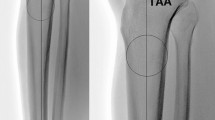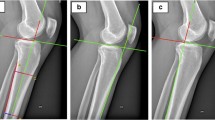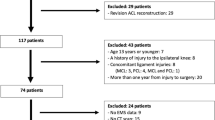Abstract
Purpose
Anatomic factors, such as posterior tibial slope (PTS) and anterior tibial subluxation (ATS) obtained by quantitative measurement, have been proposed as predictors for clinical outcomes of anterior cruciate ligament (ACL) reconstruction. However, the correlation between PTS and ATS is controversial, and the method for quantitative ATS measurement remains unsettled. This study aimed to identify the correlation between PTS and ATS in patients with injured and intact ACLs and compare the two ATS measuring protocols.
Methods
This study included 128 ACL-injured and 176 ACL-intact patients with no concomitant ligament injuries. PTS and ATS were measured on sagittal MRI. ATS was measured using two measuring protocols, including the modified protocol using the longitudinal tibial axis (axis protocol) and the established protocol using a line perpendicular to the tibial plateau (plateau protocol). Correlation analyses between PTS and ATS and between PTS and the difference in the ATS value measured under the two protocols (ATSdiff) were performed. The difference between the two ATS measuring protocols was further analyzed by trigonometric analysis. Intra- and interobserver reliability tests were performed for the axis protocol.
Results
Under the axis protocol, ATS was positively correlated with PTS in both the ACL-injured and ACL-intact groups (p < 0.001). Under the plateau protocol, no correlation was observed in the ACL-injured group. In the ACL-intact group, no correlation was observed for lateral ATS, and a negative correlation was observed for medial ATS (p = 0.001). ATSdiff was positively correlated with PTS (p < 0.001), indicating that the two protocols varied greatly in those with a steep PTS. Trigonometric analysis showed that a steep PTS influenced the measurement of ATS under the plateau protocol but not the axis protocol. Intra- and interobserver reliability tests showed good-to-excellent strength of reliability for the ATS measurement under the axis protocol.
Conclusion
ATS measured under the axis protocol was positively correlated with PTS, indicating that a steep PTS was associated with a worse anatomic tibiofemoral relationship. The axis protocol for ATS measurement is a promising method for clinical use since it is not influenced by PTS and reflects the global position of the tibia.
Level of evidence
III.



Similar content being viewed by others
Abbreviations
- ACL:
-
Anterior cruciate ligament
- ACLR:
-
Anterior cruciate ligament reconstruction
- ATS:
-
Anterior tibial subluxation
- ATSdiff :
-
The difference in the ATS value measured under the two protocols
- MRI:
-
Magnetic resonance imaging
- PTS:
-
Posterior tibial slope
References
Almekinders LC, Chiavetta JB, Clarke JP (1998) Radiographic evaluation of anterior cruciate ligament graft failure with special reference to tibial tunnel placement. Arthroscopy 14:206–211
Bernhardson AS, Aman ZS, Dornan GJ, Kemler BR, Storaci HW, Brady AW et al (2019) Tibial slope and its effect on force in anterior cruciate ligament grafts: anterior cruciate ligament force increases linearly as posterior tibial slope increases. Am J Sports Med 47:296–302
Bernholt D, DePhillipo NN, Aman ZS, Samuelsen BT, Kennedy MI, LaPrade RF (2021) Increased posterior tibial slope results in increased incidence of posterior lateral meniscal root tears in ACL reconstruction patients. Knee Surg Sports Traumatol Arthrosc 29:3883–3891
Daehlin L, Inderhaug E, Strand T, Parkar AP, Solheim E (2022) The effect of posterior tibial slope on the risk of revision surgery after anterior cruciate ligament reconstruction. Am J Sports Med 50:103–110
Giffin JR, Vogrin TM, Zantop T, Woo SLY, Harner CD (2004) Effects of increasing tibial slope on the biomechanics of the knee. Am J Sports Med 32:376–382
Grassi A, Macchiarola L, Barrientos FU, Zicaro JP, Paz MC, Adravanti P et al (2019) Steep posterior tibial slope, anterior tibial subluxation, deep posterior lateral femoral condyle, and meniscal deficiency are common findings in multiple anterior cruciate ligament failures: an MRI case–control study. Am J Sports Med 47:285–295
Grassi A, Pizza N, Bertoja JZ, Macchiarola L, Lucidi GA, Dal Fabbro G et al (2021) Higher risk of contralateral anterior cruciate ligament (ACL) injury within 2 years after ACL reconstruction in under-18-year-old patients with steep tibial plateau slope. Knee Surg Sports Traumatol Arthrosc 29:1690–1700
Grassi A, Signorelli C, Urrizola F, Macchiarola L, Raggi F, Mosca M et al (2019) Patients with failed anterior cruciate ligament reconstruction have an increased posterior lateral tibial plateau slope: a case–controlled study. Arthroscopy 35:1172–1182
Hardy A, Klouche S, Szarzynski P, Charpentier E, Beranger JS, Bauer T et al (2019) A threshold value of 3.5mm of passive anterior tibial subluxation on MRI is highly specific for complete ACL tears. Knee Surg Sports Traumatol Arthrosc 27:885–892
Hashemi J, Chandrashekar N, Gill B, Beynnon BD, Slauterbeck JR, Schutt RC et al (2008) The geometry of the tibial plateau and its influence on the biomechanics of the tibiofemoral joint. J Bone Jt Surg Am 90a:2724–2734
Hudek R, Schmutz S, Regenfelder F, Fuchs B, Koch PP (2009) Novel measurement technique of the tibial slope on conventional MRI. Clin Orthop Relat Res 467:2066–2072
Koo TK, Li MY (2016) A guideline of selecting and reporting intraclass correlation coefficients for reliability research. J Chiropr Med 15:155–163
Lee CC, Youm YS, Cho SD, Jung SH, Bae MH, Park SJ et al (2018) Does posterior tibial slope affect graft rupture following anterior cruciate ligament reconstruction? Arthroscopy 34:2152–2155
Li Y, Hong L, Feng H, Wang QQ, Zhang J, Song GY et al (2014) Posterior Tibial slope influences static anterior tibial translation in anterior cruciate ligament reconstruction a minimum 2-year follow-up study. Am J Sports Med 42:927–933
Marouane H, Shirazi-Adl A, Adouni M, Hashemi J (2014) Steeper posterior tibial slope markedly increases ACL force in both active gait and passive knee joint under compression. J Biomech 47:1353–1359
McDonald LS, van der List JP, Jones KJ, Zuiderbaan HA, Nguyen JT, Potter HG et al (2017) Passive anterior tibial subluxation in the setting of anterior cruciate ligament injuries: a comparative analysis of ligament-deficient states. Am J Sports Med 45:1537–1546
Mishima S, Takahashi S, Kondo S, Ishiguro N (2005) Anterior tibial subluxation in anterior cruciate ligament-deficient knees: quantification using magnetic resonance imaging. Arthroscopy 21:1193–1196
Nishida K, Matsushita T, Araki D, Sasaki H, Tanaka T, Hoshino Y et al (2019) Analysis of anterior tibial subluxation to the femur at maximum extension in anterior cruciate ligament-deficient knees. J Orthop Surg Hong Kong. https://doi.org/10.1177/2309499019833606
Okazaki Y, Furumatsu T, Kodama Y, Kamatsuki Y, Okazaki Y, Hiranaka T et al (2021) Steep posterior slope and shallow concave shape of the medial tibial plateau are risk factors for medial meniscus posterior root tears. Knee Surg Sports Traumatol Arthrosc 29:44–50
Shao Q, MacLeod TD, Manal K, Buchanan TS (2011) Estimation of ligament loading and anterior tibial translation in healthy and ACL-deficient knees during gait and the influence of increasing tibial slope using EMG-driven approach. Ann Biomed Eng 39:110–121
Shelbourne KD, Benner RW, Jones JA, Gray T (2021) Posterior tibial slope in patients undergoing anterior cruciate ligament reconstruction with patellar tendon autograft: analysis of subsequent ACL graft tear or contralateral ACL tear. Am J Sports Med 49:620–625
Song GY, Zhang H, Zhang J, Liu X, Xue Z, Qian Y et al (2018) Greater static anterior tibial subluxation of the lateral compartment after an acute anterior cruciate ligament injury is associated with an increased posterior tibial slope. Am J Sports Med 46:1617–1623
Song GY, Zhang H, Zhang J, Zhang ZJ, Zheng T, Feng H (2020) Excessive preoperative anterior tibial subluxation in extension is associated with inferior knee stability after anatomic anterior cruciate ligament reconstruction. Am J Sports Med 48:573–580
Sundemo D, Blom A, Hoshino Y, Kuroda R, Lopomo NF, Zaffagnini S et al (2018) Correlation between quantitative pivot shift and generalized joint laxity: a prospective multicenter study of ACL ruptures. Knee Surg Sports Traumatol Arthrosc 26:2362–2370
Tanaka MJ, Jones KJ, Gargiulo AM, Delos D, Wickiewicz TL, Potter HG et al (2013) Passive anterior tibial subluxation in anterior cruciate ligament-deficient knees. Am J Sports Med 41:2347–2352
Vahey TN, Hunt JE, Shelbourne KD (1993) Anterior translocation of the tibia at MR imaging: a secondary sign of anterior cruciate ligament tear. Radiology 187:817–819
Webb JM, Salmon LJ, Leclerc E, Pinczewski LA, Roe JP (2013) Posterior tibial slope and further anterior cruciate ligament injuries in the anterior cruciate ligament-reconstructed patient. Am J Sports Med 41:2800–2804
Yoo JH, Chang CB, Shin KS, Seong SC, Kim TK (2008) Anatomical references to assess the posterior tibial slope in total knee arthroplasty: a comparison of 5 anatomical axes. J Arthroplast 23:586–592
Yoon KH, Park SY, Park JY, Kim EJ, Kim SJ, Kwon YB et al (2020) Influence of posterior tibial slope on clinical outcomes and survivorship after anterior cruciate ligament reconstruction using hamstring autografts: a minimum of 10-year follow-up. Arthroscopy 36:2718–2727
Zhang ZY, Wang C, Maimaitimin M, Huang HJ, Pan XY, Maimaitijiang P et al (2021) Anterior and rotational tibial subluxation in the setting of anterior cruciate ligament injuries: an MRI analysis. Knee 33:365–373
Zheng T, Song GY, Feng H, Zhang H, Li Y, Li X et al (2020) Lateral meniscus posterior root lesion influences anterior tibial subluxation of the lateral compartment in extension after anterior cruciate ligament injury. Am J Sports Med 48:838–846
Funding
This study was supported by grants from the National Natural Science Foundation of China (no. 82072403).
Author information
Authors and Affiliations
Contributions
ZZ drafted the manuscript. CW and JW participated in the design of the study. XP and PM completed data acquisition and designed the measuring procedure in the software. LM and ZH developed the tables and figures in this study and participated in drafting the manuscript. QZ contributed to the acquisition and evaluations of MRIs from outpatient department. QZ, CW and JW contributed to data interpretation. XP shaped the manuscript and improved the English language writing. All the authors have read and approved the final manuscript.
Corresponding authors
Ethics declarations
Conflict of interest
The author(s) declare that they have no competing interests.
Ethical approval
Formal approval of this study (no. M2020433) was obtained from the Ethics Committee of Peking University Third Hospital (No. 49, Huayuanbei Road, Haidian District, Beijing, China).
Additional information
Publisher's Note
Springer Nature remains neutral with regard to jurisdictional claims in published maps and institutional affiliations.
Supplementary Information
Below is the link to the electronic supplementary material.
Rights and permissions
About this article
Cite this article
Zhang, Zy., Pan, Xy., Maimaitijiang, P. et al. Anterior tibial subluxation measured under a modified protocol is positively correlated with posterior tibial slope: a comparative study of MRI measurement methods. Knee Surg Sports Traumatol Arthrosc 30, 3350–3360 (2022). https://doi.org/10.1007/s00167-022-06913-8
Received:
Accepted:
Published:
Issue Date:
DOI: https://doi.org/10.1007/s00167-022-06913-8




